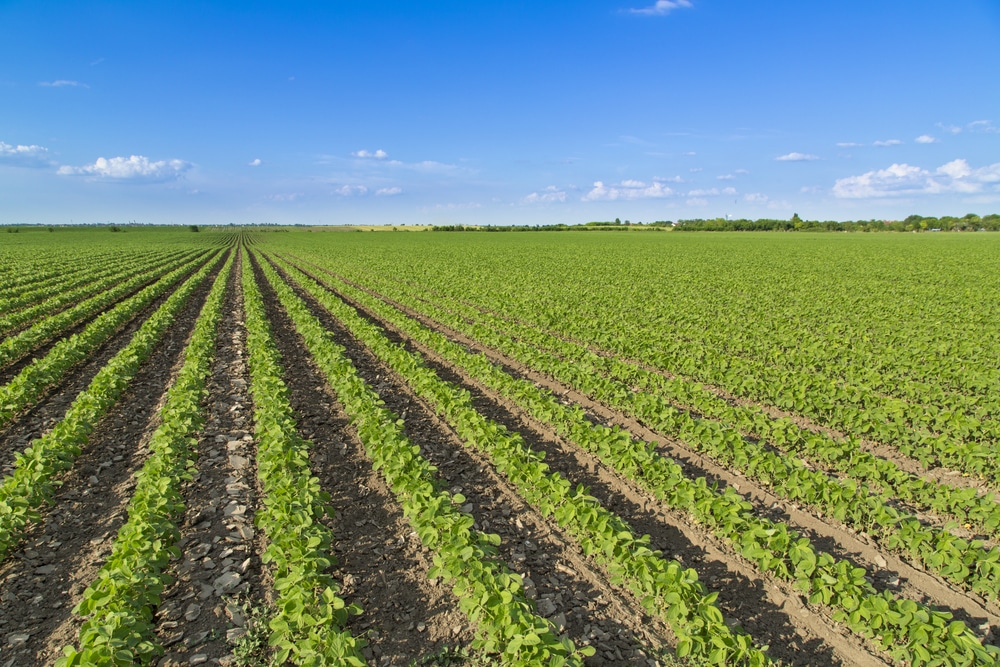Farm Journal Field Agronomist Ken Ferrie has recorded yield increases of 2 bu. to 5 bu. per acre from rolling soybeans and up to 5 bu. per acre from herbicides. Those results were with soybeans planted at the normal time. But what happens with early-planted soybeans? Planting soybeans early, so they begin to flower before the summer solstice, can boost yield, but it requires a detailed focus on management.
While Ferrie’s studies of man-made stress on early-planted soybeans are ongoing, he’s learning more about how to manage them.
With stress, timing is critical. “Charts used by insurance adjusters to evaluate the effect of hail damage illustrate the importance of growth stage,” Ferrie says. “If plants are in vegetative stages V9 to V12, 100% defoliation reduces projected yield by only 10%. But if plants have entered the reproductive stage at V10/R5, the projected yield loss is more than 85%.”
Roll Early Before Plants Become Too Brittle
“Just as with normal planting, rolling early-planted soybeans at the V1 to V2 stage gives the best response,” Ferrie says. “In our 2018 study, early-planted soybeans rolled at the V1 to V2 stage yielded 83 bu. per acre. An unrolled check plot yielded only 79 bu. per acre.”
In the same study, rolling too late, in the V2 to V3 stage, reduced yield from 81.9 bu. per acre to 79.5 bu.
Even though they rolled in the afternoon, when warmer temperatures should have made the plants less brittle, they had to stop because so many plants were breaking off.
It’s OK to roll early-planted soybeans for rocks, you might see a yield increase from branching, Ferrie says. ”But if you usually roll normal-planted soybeans 10 days after emergence, your early-
planted soybeans might not be at the same growth stage, or even emerged, because of cooler soil conditions,” he adds. ”Base rolling on the stage of the plant. You might also need to roll later in the day when the temperature is warmer.”
Herbicide Application Takes Planning
Keep the following in mind when using herbicides to stress soybeans:
Understand label restrictions and know your weeds. Some herbicides must be applied a certain number of days after planting; some are restricted based on weed size and soybean growth stage. Most post-emergence products must be applied before weeds get too big.
“You must understand the weeds you are trying to control,” Ferrie says. “Do they emerge early or later as the ground warms up? Apply the proper rate for the size of weed.”
Because of resistance, you might have to apply a combination of herbicides, some of which can burn plants.
“This makes it imperative to understand the stage of soybean growth,” Ferrie says. “Most herbicide labels recommend not burning plants after R1. The same stress that increases branching, especially of lower nodes, can cause flower, pod and bean abortion. Make sure weeds are enough of a problem to justify some yield loss.”
Don’t confuse soybean plant height and growth stage.
“At knee-high, a plant can be V10 or V10/R2,” Ferrie says. “This is even more important with early planting because the plants flower earlier. With normal planting, plants could be at V10, and a diphenyl ether herbicide could increase branching and boost yield. But with early planting, the plants could be at V10/R2, and burning will abort flowers and pods.”
Ferrie’s studies show why growth stage is so important, and how the situation changes with early planting. In 2018, he sprayed plants that were flowering before the solstice (at the V7/R2, or full flower, stage) with a full rate of diphenyl ether. Those soybeans yielded 70.9 bu. per acre, while an unsprayed check yielded 79.1.
In 2019, Ferrie sprayed a herbicide on two soybean plots that were planted in May and flowered after the solstice. A 3.2-maturity variety, burned at the V9 to early R1 stage, made 78 bu. per acre compared with 74 bu. in an unsprayed check. A 4.1-maturity variety, sprayed at V9, yielded 78 bu. per acre, versus 73.5 bu. where it was not sprayed.
From the road, an early-planted soybean might look like it’s ready to spray, based on what you are used to seeing with normal planting, Ferrie says. But closer examination might reveal it’s already as far along as R3. Spraying will reduce yield.
With early planting, you can no longer apply a herbicide based on days after planting. “You must scout to determine soybean growth stage and weed height,” Ferrie says.
One-Two Punch To Yield
Take natural stress into account. “Although burning can stimulate branching and yield, if you burn drought-stressed soybeans, the combination might work against you,” Ferrie says. “Stress in the vegetative stages tends to slow maturity, but stress in the reproductive stages speeds maturity. If early-planted soybeans in the reproductive stage are under drought stress, burning could double the potential for yield loss while speeding maturity of the plant. Once a plant reaches R5, it will stop growing, and you might get stunted plants.”
